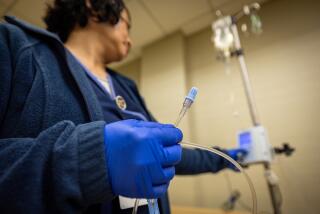Zeroing in on Alzheimer’s
A talk-radio host who was interviewing me recently about memory loss led off by asking what the big deal was about Alzheimer’s disease: “I mean, really, here’s this disease where you don’t even know you have it, and you’re not in pain, so what’s so bad about that?”
Maybe he was trying to be provocative, or maybe he was one of those rare individuals who hasn’t watched the awful, poignant, frustrating slide of a loved one or a friend or a co-worker or a neighbor into insensibility, but if he hasn’t yet, his turn is coming: According to the most recent estimates of the Alzheimer’s Assn., upward of 15 million Americans will have the disease by 2050; 1 in 8 baby boomers can expect to get it.
I was thinking about those numbers and the public health crisis they portend (to say nothing of the protracted suffering of individuals and families) when I saw a small article on the business page of the newspaper about a new drug in development. Typically when there’s an article about a new Alzheimer’s drug, it’s accompanied by the word “breakthrough,” a word calculated to inspire hope in the afflicted and their loved ones -- hope that more often than not will be dashed because it will turn out that the breakthrough occurred in a petri dish, not in people, and therefore doesn’t pan out, or doesn’t stand up to peer review, or can’t be replicated.
Because the public is desperate for good news, and because drug developers are often looking to attract investors, hype happens. The problem is that most of the time we don’t know that it’s hype, so we reach out and grab on to what we think is a lifesaver, till it too sinks.
But this article was different. No trumpets were blaring; it was uncharacteristically quiet. It simply said that a Danish drug company had acquired the European rights to an Alzheimer’s drug in development by an American drug company. That new drug, the article went on to say, had just finished Phase 3 testing, and results were expected later this month. Phase 3 trials are the final lap in the long race to Food and Drug Administration approval. To get there, the drug would have had to have been proved safe; Phase 3 would tell if it is effective.
And so I wondered: Did the Danes have a bead on the outcome? Might that talk-radio guy actually live out his days without being touched by Alzheimer’s? And the answer I came up with was: just possibly, yes.
This was after I’d read blog posts of people whose family members were enrolled in that Phase 3 clinical trial. Some of the participants had been given a placebo, while others had received the medication under review (though when the trial period was over, all participants were given the option of taking the medication itself, which many of them did). This meant that some of the blog posters knew their loved one was taking the drug, while others could only speculate.
Even so, no one was reporting incredible results. The improvements, when they occurred, were measured and incremental. If you were to read about them, you might go away disappointed, dismissing this drug as just another broken promise. And if you did, you’d have missed the point.
For about 100 years, ever since Alois Alzheimer autopsied the brain of the first person to be identified with the disease that bears his name, the signature of Alzheimer’s disease has been the plaques and tangles he found there. Conventional wisdom said that those plaques and tangles strangled the brain, taking personality, wherewithal, knowledge and perception with it. Recently, though, advances in brain-imaging technology, molecular biology and genetics have caused scientists to reevaluate the cause of Alzheimer’s. The new thinking is that, for reasons that are still being worked out, the body produces too much of a peptide called beta-amyloid 42, which floods the brain.
As Rudolph Tanzi, a professor of neurology at Harvard Medical School, explains it: “The main place where a-beta 42 does its work is in the synapse. So every minute of the day, an Alzheimer patient is producing a-beta 42, for one reason or another, and it’s accumulating in the brain ... it’s accumulating ... in the synapse. Way, way before the plaques form, you get tiny little aggregates of a-beta 42. The peptides stick together and they get into the synapse and they disrupt the most basic synaptic function for learning and memory.”
The drug that just finished Phase 3 tests is one of the first pharmaceuticals designed on the basis of this new paradigm. For the first time in a century, we’ve got Alzheimer’s drugs aimed directly at what is now believed, on the basis of compelling evidence, to be the target.
Still, you may be wondering about those bloggers and their less than gripping reports: What’s so great about a drug that is only having modest effects? The answer lies in the science, which suggests that if this new approach is really going to work, it has to be engaged quite early, before the beta-amyloid begins to wreak havoc. (So far, there is no therapy that can revive dead brain cells.) The people in the trial were already impaired, but the idea behind this drug, and the many others in development aimed at clearing the beta-amyloid or preventing its buildup, is to intervene before serious damage has been done.
That’s where another recent advance will come into play. In the last year or so, a number of research groups, most notably at Stanford University and New York University, have found what they believe to be markers in the blood and cerebral spinal fluid that, in preliminary tests, appear to predict Alzheimer’s disease years before there are outward symptoms. In the face of a disease without a cure, that knowledge may not be welcomed. Paired with a medication that is meant to work before the disease has announced its presence, though, early diagnosis may turn out to be just what many of us are -- and all of us should be -- waiting for.
But for that to happen, something else is necessary. As former Supreme Court Justice Sandra Day O’Connor, whose husband suffers from Alzheimer’s disease, told the Senate Special Committee on Aging last month, funding for Alzheimer’s research has declined in real dollars over the last five years. In her testimony, O’Connor pointed out that in this country, we spend about $150 billion a year to care for people with Alzheimer’s. Contrast this with the $644 million we spend to look for cures and interventions. Around the same time that O’Connor was in Washington, one of the researchers working on the early diagnosis bio-markers study at NYU told me that their funding was drying up.
It is too early to become complacent. Rather, complacency should be a goal -- the peace of mind we might enjoy once the new drugs make it down the pipeline and the novel diagnostic tools are in place, thanks to the money we devote now and in the coming years to making that happen. Penny-wise, not pound-foolish? That would be a true breakthrough.






